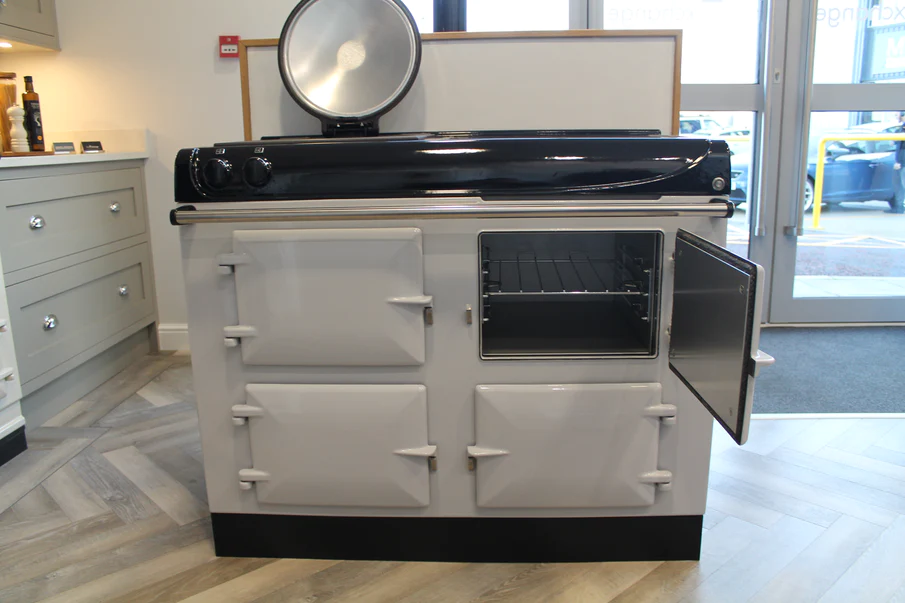
Does an Aga Cooker Need Ventilation?
Gases and fumes that can be emitted during cooking need to be removed from the air, as they contain many toxic elements that can cause serious damage. Certain types of Aga cookers require ventilation measures such as hoods, fans or flues to get rid of these fumes, while others have built in ventilation methods. In this blog, we will detail the different types of ventilation available for Aga cookers so you can make the best decision for your needs.
So does an Aga cooker need ventilation? Not all Aga cooker models require ventilation, however the ones that do will require careful planning before installation. Some types of ventilation mean the Aga cooker will need to be placed on an external wall, such as hoods, while others offer more flexibility, including certain types of Aga flue.
Read on to find out the ventilation requirements for Aga cookers and how to keep them clean.
HOW DO YOU VENT AN AGA COOKER?
Depending on the type and model of your Aga cooker, it may require ventilation to remove steam and odours from your home. Both external and internal ventilation is available to suit your personal requirements and living arrangements, so when you are planning to add your Aga cooker, take into account where the ventilation system will be located as some may need direct access outside. To find out more about the different types of Aga cookers, check out our helpful guide.
Below, we have detailed the different options available for your Aga ventilation:
There are a few different kinds of hood that can be installed above your Aga cooker to remove air extracted from your kitchen after cooking. These hoods can have different shapes and aesthetics to meet your needs and personal style choice. Depending on where your Aga cooker is positioned in your cooking area, you can stick to traditional type hoods, or even build one into your kitchen island for a more modern approach.
Extraction hoods send the air outside of your home using ducting. The air is not filtered or processed during the process, it simply exits the house. Although this is considered an efficient ventilation system as it does not recirculate the air back into the room, it can produce a lot of sound. Make sure to plan where the Aga and hood will go from the very beginning if you want it to fit into your kitchen’s aesthetic.
Recirculation hoods use grease filters and charcoal filters to remove smells, grease and smoke from the air in your kitchen after cooking. These filters will need to be replaced occasionally to ensure they work properly. As recirculation hoods do not require ducting, they are considered a cheaper alternative, however they are less effective than other types of hood as they have to process the air.
The benefits of installing a hood on top of your Aga cooker include controlling the humidity in the air around your cooking area as well as steam, fumes and food smells. Long cooking times can increase the amount of heat in your kitchen, especially with Agas as they are always turned on and producing heat. Steam and heat can cause wallpaper and paint to peel so having a hood can reduce this issue by extracting them.
The alternative to installing and paying for a full hood is an Aga flue which often comes with the Aga.
WHAT TYPES OF AGA COOKERS DON’T REQUIRE VENTILATION?
Some types of Aga cookers do not require ventilation due to the way they are powered. Electric Aga cookers do not emit any fumes during the cooking process so will not require ventilation. Do some have built-in ventilation?
WHAT IS AN AGA FLUE?
Aga flues are another common method of ventilation in kitchens, replacing the need for a full hood. Flues can also be found in other appliances in the home such as chimneys and leading away from heaters, boilers or generators as a method of conveying exhaust gases outside of the home.
Aga flues will need maintenance to ensure they are clean and provide optimum extraction efficiency, this includes being swept once or twice a year by a professional. As with hoods, there are a few different types of flue that can be used to ventilate your Aga cooker.
| Type | Description |
| Conventional Flue | A conventional flue is built into a chimney and uses natural air circulation to direct smoke, gases and combustibles away from the fire. The air from around the Aga cooker is drawn rather than pulling in air from outside the home. |
| Balanced Flue | Balanced flues are used with gas cookers with two pipes, one external and one internal. The external pipe brings air into the house from outside to allow the combustion process to take place. The internal pipe removes waste gases and smoke out of the building. |
| Power Flue | Power flues provide an option for houses with no chimney, with the additional benefit of removing the limitations of where the Aga cooker can be installed, including both external and internal walls or even kitchen islands. |
AGA COOKERS AT RANG EXCHANGE
At Rang Exchange, we have a large variety of different Aga models to suit your space and requirements. If you are unsure which model is the right one for you, we have a helpful guide available to help you make an informed choice.
With a full range available including Gas Aga Cookers, Oil Aga Cookers and Electric Aga Cookers, Range Exchange has everything you need to introduce an Aga into your kitchen. We even offer flues with some of our Agas.
